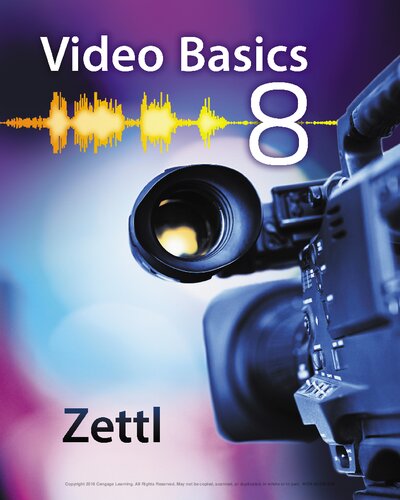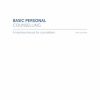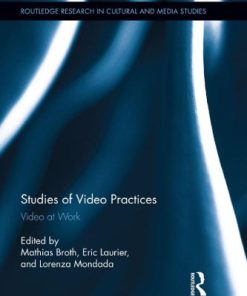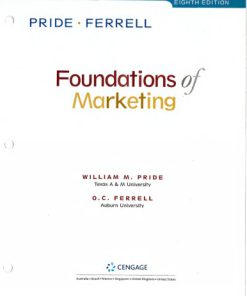Video Basics 8th Edition by Herbert Zettl 1109220747 9798214355849
$50.00 Original price was: $50.00.$25.00Current price is: $25.00.
Video Basics 8th Edition by Herbert Zettl- Ebook PDF Instant Download/Delivery:1109220747 ,9798214355849
Full download Video Basics 8th Edition after payment

Product details:
ISBN 10:1109220747
ISBN 13:,9798214355849
Author:Herbert Zettl
Drawing from Herbert Zettl’s vast expertise as an Emmy award–winning producer, director, and innovator, VIDEO BASICS, 8th Edition, delivers the most authoritative, current, and technically accurate student guide to video production available. Meeting the need for a briefer book than the more comprehensive TELEVISION PRODUCTION HANDBOOK, the eighth edition of VIDEO BASICS presents thorough yet streamlined video instruction that can be covered in a single semester. It moves students from video concepts and processes to production tools and techniques, and, ultimately, the production environment (studio and field, indoors and out) and its effects. A more conceptual framework leads students from the idea (what to create) to the image (how to create) on video. In addition, the accompanying MindTap Radio, Television & Film provides an interactive digital experience to help students ensure their course success.
Video Basics 8th Table of contents:
Part I. Production: Processes and People
Chapter 1. Production Process
Production Model
Production Phases
Importance of Preproduction
Preproduction: Generating Ideas on Demand
Brainstorming
Clustering
Preproduction: From Idea to Script
Program Objective
Angle
Evaluation
Script
Preproduction: From Script to Production
Medium Requirements
Budget
Media Convergence
Digital Cinema and Video
Studio and Field Production
Main Points
Chapter 2. Production Team: Who Does What When?
Production Teams
Preproduction Team
Production Team
Postproduction Team
Passing the Buck
Taking and Sharing Responsibility
Production Schedule and Time Line
Crew Call
Production Workflow
Main Points
Part II. Image Creation: Digital Video and Camera
Chapter 3. Image Formation and Digital Video
Basic Image Formation: Video Raster
Color
Scanning
Video Raster Formats
Flat-Panel Displays
What Is Digital?
Digital Process
Analog and Digital Signals
Digital System
Compression and Codecs
Downloading and Streaming
Digital Process Restated
Analog Signal
Digital Signal and Quantizing
Sampling
Compression and Transport
Why Digital?
Main Points
Chapter 4. Video Camera
Basic Camera Function and Elements
Function
Lens
Beam Splitter and Sensor
Shutter
Video Signal Processing
Viewfinder and Monitor
Types of Cameras
Large Camcorders
Small Camcorders
Smartphones
ENG/EFP Cameras
Studio Cameras
DSLR Cameras
Digital Cinema Cameras
3D Camcorders
Main Points
Chapter 5. Operating the Camera
Basic Camera Movements
Pan
Camera Mounts and How to Use Them
Handheld and Shoulder-Mounted Camera
Tripod-Supported Camera
Studio Pedestal
Special Camera Mounts
Operational Features
Focusing
Shutter Speed
Zooming
White-Balancing
General Guidelines
Checklist: Camcorders and ENG/EFP Cameras
Checklist: Studio Cameras
Main Points
Chapter 6. Looking through the Viewfinder
Framing a Shot
Aspect Ratio
Field of View
Vectors
Composition
Psychological Closure
Manipulating Picture Depth
Defining the Z-Axis
Defining the 3D Z-Axes
3D Lens Separation and Convergence
Lenses and 2D Z-Axis Length
Lenses and Depth of Field
Lenses and Z-Axis Speed
Controlling Camera and Object Motion
Controlling Camera Movement and Zooms
Controlling Object Motion
Main Points
Part III. Image Creation: Sound, Light, Graphics, and Effects
Chapter 7. Audio and Sound Control
Sound Pickup Principle
Microphones
How Well Mics Hear: Sound Pickup
How Mics Are Made
How Mics Are Used
Sound Control
Manual Volume Control
Audio Mixer
Audio Console
Cables and Patch Panel
Sound Recording
Digital Audio Recorders
Optical Discs: CDs and DVDs
Audio Postproduction
Audio Postproduction Room
Automated Dialogue Replacement
Synthesized Sound
Sound Aesthetics
Context
Figure/Ground
Sound Perspective
Continuity
Energy and Mood
Main Points
Chapter 8. Light, Color, and Lighting
Light
Types of Light
Light Intensity
Measuring Illumination
Contrast
Shadows
Attached Shadows
Cast Shadows
Falloff
Color
Additive and Subtractive Color Mixing
Color Television Receiver and Generated Colors
Color Temperature and White-Balancing
Lighting Instruments
Spotlights
Floodlights
Special-Purpose Spotlights and Floodlights
Lighting Techniques
Operation of Lights
Checklist: Lighting Safety
Studio Lighting
Light Plot
Last-Minute Lighting Techniques
Field Lighting
Checklist: Field Lighting Guidelines
Main Points
Chapter 9. Graphics and Effects
Principles of Graphics
Aspect Ratio
Essential Area
Readability
Color
Animated Graphics
Style
Standard Electronic Video Effects
Superimposition
Key
Wipe
Digital Effects
Digital Image Manipulation Equipment
Common Digital Video Effects
Synthetic Image Creation
Main Points
Part IV. Image Control: Switching, Recording, and Editing
Chapter 10. Switcher and Switching
Production Switcher
Basic Switcher Functions
Switcher Layout
Program Bus
Preview Bus
Key Bus
Fader Bar and Auto-Transition
Delegation Controls
Switcher Operation
Working the Program Bus: Cuts-Only
Working the Mix Buses: Cuts
Working the Mix Buses: Dissolves
Working the Effects Bus: Wipes
Working the Key Bus: Keys
Working the Downstream Keyer
Chroma Keying
Special Effects
Automated Production Control
APC Function
Control Panels
Main Points
Chapter 11. Video Recording
Digital Recording Systems
Digital Recording
Recording and Storage Media
Digital Video Recorders
Video Stabilization
Video-Recording Process
Checklist: Before Video Recording
Checklist: During Video Recording
Checklist: After Video Recording
Main Points
Chapter 12. Digital Video Editing
Editing Principle and System Setup
Basic Editing Principle
Editing System Setup
Editing Interface
Checklist: Production Tips for Postproduction
Basic Editing Phases
Checklist: Postproduction Preparations
Pre-Edit Decision Making
Off-Line and On-Line Editing
Exporting to the Edit Master
Main Points
Chapter 13. Editing Principles
Editing Purpose
Editing Functions
Combine
Condense
Correct
Build
Aesthetic Principles of Continuity Editing
Mental Map
Vectors
On- and Off-Screen Positions
Cutting on Action
Aesthetic Principles of Complexity Editing
Intensifying an Event
Supplying Meaning
Main Points
Part V. Production Environment: Studio, Field, and Synthetic
Chapter 14. Production Environment: Studio
Video Production Studio
Physical Layout
Major Installations
Studio Control Room
Image Control
Sound Control
Master Control
Workflow and Quality Control
Content Ingest
Storage and Archiving
Studio Support Areas
Scenery and Property Storage
Makeup and Dressing Rooms
Scenery, Properties, and Set Dressings
Scenery
Properties
Set Dressings
Set Design
Process Message
Floor Plan
Prop List
Using the Floor Plan for Setup
Main Points
Chapter 15. Production Environment: Field and Synthetic
Electronic News Gathering
News Gathering
Transmission
Electronic Field Production
Preproduction: Remote Survey
Production: Outdoors and Indoors
Checklist: Field Production Equipment
Postproduction: Wrap-Up
Big Remotes
Synthetic Environments
Computer-Generated Settings
Computer-Generated Environments
Computer-Controlled Environments
Main Points
Part VI. Production Control: Talent and Directing
Chapter 16. Talent, Clothing, and Makeup
Performing Techniques
Performer and Camera
Audio and Lighting
Timing and Prompting
Acting Techniques
Environment and Audience
Close-Ups
Repeating Action
Auditions
Clothing
Texture and Detail
Color
Makeup
Technical Requirements
Materials
Main Points
Chapter 17. Putting It All Together: Directing
Script Formats
Fact, or Rundown, Sheet
News Script
Two-Column A/V Script
Single-Column Drama Script
Visualization
Image
Preparing for a Multicamera Studio Production
Reading the Floor Plan
Control Room Directing
Terminology
Time Line
Rehearsals
Directing the Multicamera Show
Single-Camera Directing
Major Differences
Single-Camera Studio Directing
Single-Camera Field Production
People also search for Video Basics 8th :
video basics 8th edition
video basics 8th edition pdf
video basics 8th edition free pdf
khan academy 8th grade math videos
video basics 8
Tags:
Herbert Zettl,Video,Basics
You may also like…
Politics & Philosophy - Anthropology
Fiction - Humour
Studies of Video Practices Video at Work 1st Edition Mathias Broth
Medicine - Medicine & Nursing Reference
The Basics: A Comprehensive Outline of Nursing School Content 8th Edition Kaplan Nursing
Technique - Food Manufacturing
Business & Economics
Foundations Of Marketing 8th Ed. 8th Edition William M. Pride
Business & Economics - Industries












